Anyone who claims to comprehend every nuance of Ireland’s sailing story during 2018 is living in a state of happy delusion writes W M Nixon. For sure, much that happened followed the set path of the annual programme at home and abroad, as it has developed down the years. And as the season unfolded, it often produced results that were broadly in line with expectations.
But equally, there were bizarre twists of fate which found the sailing community and their supporters avidly following events afloat of a kind they’d never seen before, while time-honoured annual fixtures produced unprecedented outcomes.
It started almost immediately in January, when the traditional boat community in Ireland found its numbers growing and its international interest greatly increased with focus on Oldcourt in West Cork, where the restoration of the historic 1926-built 56ft Conor O’Brien trading ketch Ilen reached a crucial phase for the combined efforts of Liam Hegarty’s boatyard at Oldcourt, and their partners in the Ilen Boat-building School in Limerick directed by Gary MacMahon.
In an eleven-year project which has had to stretch resources very thinly indeed at times to keep going at all, the task in January 2018 was to get the Ilen safely out of the ancient Top Shed at Oldcourt and into a re-fit berth where the complex work could be completed in order to have her available for sea trials and certification during the summer.
![]() The restored 1926 ketch Ilen sails past the famous Baltimore Beacon in September. But back in January, there was still much work to do, including delicately-balanced boat moving operations in a very confined space. Photo: Ilen Network
The restored 1926 ketch Ilen sails past the famous Baltimore Beacon in September. But back in January, there was still much work to do, including delicately-balanced boat moving operations in a very confined space. Photo: Ilen Network
In a modern fully-equipped yard this manoeuvre would be straightforward. But Oldcourt is a time capsule of ancient equipment, and a crowded one at that. So the fact that, despite occasional winter storms, in January there were halcyon days of complete calm when the moves were safely completed, clearly revealing that Ilen’s Guardian Angel was at work.
February by complete contrast was a month of glitzy happenings, with the style being set by the annual Volvo Sailor of the Year awards at the RDS in Dublin on Friday, February 9th. No other crowded and cheerful nautical happening gives a better overview of the Irish sailing and boating community in all its extraordinary diversity in a mood of happy celebration, and the applause rose to the rafters as Howth YC’s Conor Fogerty was announced as having emerged from a competitive field to be Sailor of the Year on the strength of his victory in the storm-tossed Single-Handed Transatlantic Race 2017.
He’d barely had time to digest that before he and a Howth team were off to race two boats in the RORC Caribbean 600 from Antigua, a notably heavy-weather event of torn sails in the Caribbean sunshine. Yet Fogerty won his class in his Sunfast 3600 Bam! for the second time, while clubmates Michael Wright and Kieran Jameson and their team on the chartered Lombard 46 Pata Negra took second in their class.
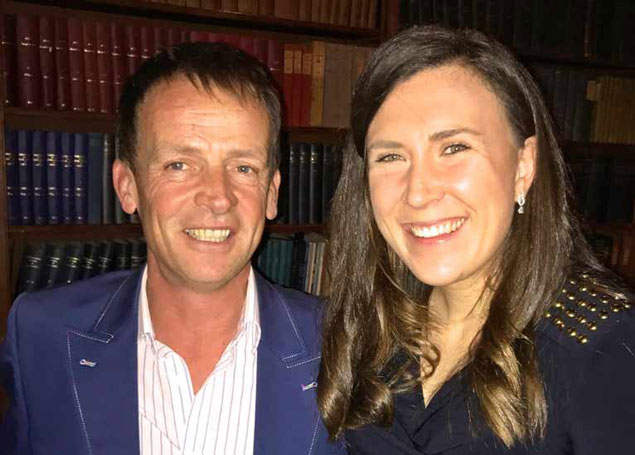 Conor Fogerty, who became Sailor of the Year in February, with his predecessor in the role, 2016 Olympic Silver Medallist Annalise Murphy. Photo Brian Turvey
Conor Fogerty, who became Sailor of the Year in February, with his predecessor in the role, 2016 Olympic Silver Medallist Annalise Murphy. Photo Brian Turvey
Back home, February also saw the annual early season gathering of the Optimists in force at Baltimore, when the hospitable West Cork port leaps out of any winter torpor to fill the harbour with small white four-sided sails in a mixture of competition and training. But then, just as February was morphing into March and we might have hoped for surer signs of spring, the Beast from the East in the form of Storm Emma arrived, and while the whole country was affected, the East Coast took a battering in storms hitting Force 11.
Even the mighty ramparts of Dun Laoghaire Harbour suffered on March 2nd with the base for the DBSC West Pier Starter’s Hut swept away, though the hut itself is fortunately removed in winter for safe keeping. But across Dublin Bay in Howth, the effect was more substantial with a boat storage shed on the East Pier so seriously damaged that it was feared the seven historic Howth 17s stored therein – some dating from 1898 - might all be lost.
But a remarkable community effort saw the damaged boats retrieved as soon as the weather had eased. Only one was a write-off, and as her ballast keel was saved, she is now being re-built according to international classic rules and through the good offices of Ian Malcolm at a French boat-building school in Douarnenez. This is part of an informal yet very real international movement to strengthen Ireland’s classic fleets, with new Dublin Bay Water Wags seemingly always coming along. In West Cork too, several specialist yards are turning out work of international standard. And new Mermaids have been built at Foynes, while across the Shannon Estuary at Kilrush, Steve Morris is re-building Dublin Bay 21s in a fascinating project inspired by Hal Sisk.
 Thanks to the lock gates for the Marina, Kilrush Creek has ample space for closely fought university racing, and it is also home to high-standard boat-building projects.
Thanks to the lock gates for the Marina, Kilrush Creek has ample space for closely fought university racing, and it is also home to high-standard boat-building projects.
Kilrush was the setting for an event which set everyone on the road to recovery from Storm Emma when good sailing weather arrived on the weekend of March 9th to 11th for the annual Irish Universities Team Championship, jointly staged by NUI Galway and University College Cork. A remarkable 194 students turned up to provide a huge diversity of teams, and from the midst of it University College Cork - captained by Brendan Lyden - emerged as the 2018 Champions.
The presence of Olympic hopeful Fionn Lyden of Baltimore in the successful Cork team was particularly encouraging. Since winning the All-Ireland Championship 2017 at Mullingar in October, Fionn Lyden’s training programme for the Olympic Finn had been seriously set back by a mysterious virus which saw him out of condition and losing weight.
Thus his appearance at Kilrush was good news, and he revealed later he’d been persuaded to go as part of a recovery plan, candidly admitting that being part of a team helped restore his mojo – the Olympic trail can be a lonely, exhausting and sometimes unhappy experience.
This proved to be the harbinger of other reminders that though Irish Sailing may seem - by comparison with other sports in this country – to get a very generous Sports Ireland grant for its Performance Sailing Squad currently aiming at the Tokyo 2020 Olympics, by international standards it is minuscule. The Dutch Olympic sailors, for instance, have to “get by” on €18 million a year, with full support teams to match.
Irish Olympic hopefuls by contrast often seem to be on a solo run, despite the support of their families and friends and coaching setups stretched to the limits and beyond, and the stress can show. The dependence of a successful Olympic programme on avoidance of injury and illness was brought home to us all during 2018 not only by the virus which halted Fionn Lyden’s progress, but also by the many weeks lost by Aoife Hopkins’ plans in her Laser Radial campaign through a persistent infection of tonsillitis. And then the need for everything to be just right was underlined when the new Annalise Murphy/Katie Tingle 49erFX campaign was de-railed when Katie sustained a broken arm in a training accident in Dublin Bay.
 Not for the faint-hearted….Katie Tingle and Annalise Murphy training in their demanding 49erFX. Photo: Afloat.ie/David O’Brien
Not for the faint-hearted….Katie Tingle and Annalise Murphy training in their demanding 49erFX. Photo: Afloat.ie/David O’Brien
But before all this began to slot into place, Irish sailing had a very special happening at the beginning of April, when Enda O’Coineen returned to Les Sables d’Olonnne to complete his inspirational round the world Vendee Globe in his own inimitable style. He may have done it in two parts instead of the Vendee Globe’s one, and he may have done it in two different boats after a dismasting and other damage, but he did it nevertheless in the well-established unsinkable Kilcullen style. And it’s arguable that he and his unique approach are now better remembered than the actual winner of what had begun as the 2016-2017 Vendee Globe.
 The unsinkable Enda – thanks to his indomitable spirit, Enda O’Coineen is now probably the best-remembered of the participants in the Vendee Globe 2016-17
The unsinkable Enda – thanks to his indomitable spirit, Enda O’Coineen is now probably the best-remembered of the participants in the Vendee Globe 2016-17
Back in mainstream Irish sailing, even with the structural timing changes imposed by the Volvo Ocean Race schedule, the Irish programme was busy, with the inaugural Wave Regatta at Howth at the start of June, sponsored by Wright Hospitality with a longterm planned biennial staging, building itself successfully round the traditional Lambay Race.
And by the time the Wave Regatta had arrived, so too had summer. But until the beginning of June, it had been a little uncertain about asserting itself. The Beast from the East at the beginning of March had ushered in an extended period of weather so cold and miserable that it became known as “the longest winter ever”. It went on through April, and though May had occasional bursts of good weather which increased as the month went on, it wasn’t until June that that summer really did arrive. And having done so, it overdid itself completely, giving two months of total sunshine which eventually became serious drought.
But despite the developing odd weather which may in fact be the New Normal under Climate Change, Irish sailing had been increasingly active in time-honoured style since April both at home and abroad, with Meathman Tom Dolan going on from his good placing in the Minitransat in November 2017 to take the First Rookie placing in the Figaro Two-Handed Transat in late April to the Caribbean, - a good omen for the big one itself, the URGO Figaro Solo in September when he’d be sailing Smurfit Kappa single-handed.
In a different area of sailing entirely, early April saw the annual Volvo Irish Sailing Youth Pathway National Championship at Dun Laoghaire, four days of racing slipped in under the weather radar with style to provide racing for a record fleet. It was hot racing in a cold climate which saw Jack Fahy of the co-hosting Royal St George YC (with NYC) win the Lasers from clubmate Tom Higgins in second and Jamie McMahon of Howth in third, while in the 420s Nicola and Fiona Ferguson of the National won from Gemma McDowell and Emma Gallagher of Malahide, with RStGYC’s Grace O’Beirne and Kathy Kelly third.
A tidy turnout of 78 Optimists – the biggest class – saw another Justin Lucas win which he shares between two clubs - Royal Cork and Tralee Bay – second slot going to Johnny Flynn of Howth and the George, whiles James Dwyer Matthews of Royal Cork and Kinsale was third.
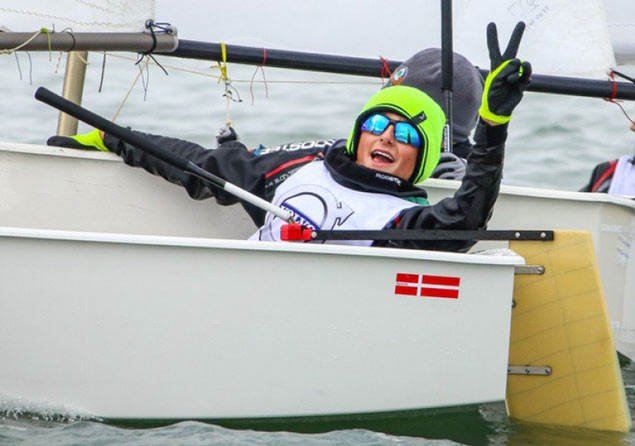 Justin Lucas was winner of the Optimists, the biggest class at the Youth Pathway national in Dublin Bay. Photo Afloat.ie/David O’Brien
Justin Lucas was winner of the Optimists, the biggest class at the Youth Pathway national in Dublin Bay. Photo Afloat.ie/David O’Brien
The Laser 4.7s provided an excellent result for the Royal Cork who took first and third with Atlee Kohl and Cathal O’Regan, while Alana Coakley of RStGYC was undoubtedly top girl at second overall. And in the Toppers, it was again the Royal Cork which showed itself to be as much as club of the future as it is of the present and a very long and distinguished past, as they took first with David Jones in a fleet of 35, with Erin McIlwaine of Newcastle second and top girl, while Hugh O’Connor of the National was third.
It was the same Hugh O’Connor who was to go on in early August to take second in the Topper Worlds in China in a record fleet plagued by light airs at Shenzen. But by that time, Irish sailing at home was already looking back on the most fascinating season, with late April seeing club sailing coming to life with the usual incalculable input by enthusiastic volunteers. Meanwhile, towards the horizon the Irish Sea Offshore Racing Association was also swinging into action, with Chris Power Smith’s J/122 Aurelia from the Royal St George YC showing signs that she’d a good season ahead to challenge the dominance of the Welsh-based Mojito.
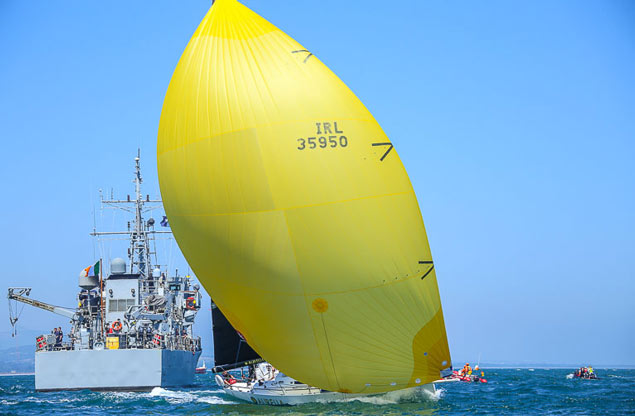 Chris Power Smith’s J/122 Aurelia – seen here at the start of the Round Ireland Race at Wicklow – was one of the most consistent performers in 2018. Photo: Afloat.ie/David O’Brien
Chris Power Smith’s J/122 Aurelia – seen here at the start of the Round Ireland Race at Wicklow – was one of the most consistent performers in 2018. Photo: Afloat.ie/David O’Brien
From north of Dublin Bay, Pat Kelly from Rush and his family with the J/109 Storm – 2017 Irish J/109 Champions – spent May campaigning in Scotland, where they’d been attracted by the new RC 35 class for boats between 32ft and 38th LOA in the IRC rating band of 1.015 and 1.040, and they’d a fine old time of it, with two major regatta wins already recorded by the time they got to the Silvers Scottish Series at the end of the month.
That rounded out the Scottish raid in high style, with Storm winning the RC 35 Class and the top title, while John Hall’s J/109 Something Else (NYC) was second in the RC 35s, and in Class 1 the Douglas brothers from Carrickfergus won with their J/133 Jacana while second went to Conor Phelan’s Ker 36 Jump Juice from Royal Cork.
So the Irish returned to the Howth Wave Regatta the following weekend – June Bank Holiday - in fine form. After a dampish start on the Friday, summer was there to greet them big time on Saturday for a genuine fun event, with 164 boats at the core of the regatta. Some of them were determined to make sure that the victors of Scottish racing were brought down a peg or two, for although Storm had the special satisfaction of winning the 114-year-old Lambay Race itself, Andrew Algeo’s Juggerknot won the J/109 Class overall, while the Regatta Supreme Champion was Dave Cullen of HYC’s immaculately-prepared Half Ton Classic Checkmate XV, which then went on to win her class in all the Dun Laoghaire regattas in June and July.
 Dave Cullen’s classic Half Tonner Checkmate XV in the summery perfection of Howth Wave Regatta, which she won overall in a season-long string of successes which concluded with the overall victory in the Half Ton Classics International Championship in Belgium.
Dave Cullen’s classic Half Tonner Checkmate XV in the summery perfection of Howth Wave Regatta, which she won overall in a season-long string of successes which concluded with the overall victory in the Half Ton Classics International Championship in Belgium.
Late June meanwhile had seen two very different events. Towards the end of the month, Gregor McGuckin departed the National Yacht Club in Dun Laoghaire in his beefed-up vintage Biscay 36 Hanley Energy Endurance to get to the start of the Golden Jubilee Golden Globe Race from Les Sables d’Olonne on July 1st, a boat-size-and-equipment-restricted re-enactment of Robin Knox-Johnston’s pioneering non-stop global circumnavigation in the 32ft ketch Suhaili fifty years ago.
In its strict boat and equipment limitations, it provides probably the slowest way of getting round the world by boat in 2018, so it was quite a contrast to find that in late June, round Ireland unrestricted powerboat record holder John Ryan of Arklow was in Cork awaiting suitable conditions to establish a new Cork-Fastnet-Cork record.
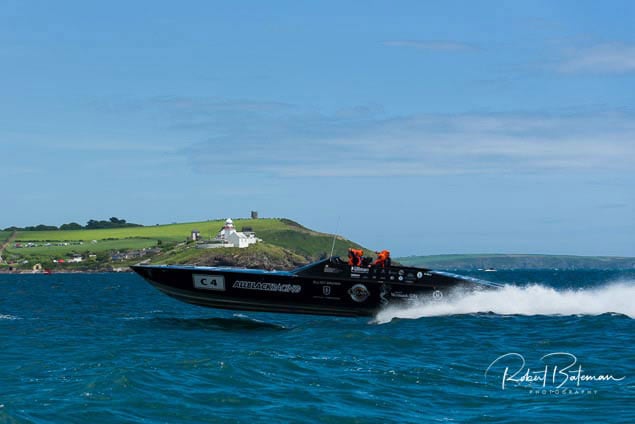 John Ryan’s Allblack SL44 created a new Cork-Fastnet-Cork record of 100.99 kph in June. Photo: Robert Bateman
John Ryan’s Allblack SL44 created a new Cork-Fastnet-Cork record of 100.99 kph in June. Photo: Robert Bateman
They didn’t need a very big weather window as their boat Allback SL44 is capable of incredible speeds on mirror-like water. But by any standards the average speed they established of 100.99 kph – despite “moderate to rough” conditions - in a time of 2 hours 6 minutes 47 seconds is going to take some beating, and in its honour the Irish Powerboat Club inaugurated the FPT Allblack Trophy for challengers to aim for, giving it for safe keeping to the Royal Cork Yacht Club – the world’s oldest yacht club has 298 years of experience of looking after trophies…..
Around the time Allback SL44 record was being set, the fleet was gathering for the 20th staging of the Round Ireland Race from Wicklow, the biennial 704-mile classic which is now such a central part of the entire Irish sailing scene that almost everyone wants to have done it at least once, and many are “persistent offenders”.
High summer was on Wicklow Bay and Ireland generally as the fleet sped away in a brisk nor’easter, but it emerged that off the west coast, that brisk nor’easter was blowing old boots, and making north in the open Atlantic made for hard pounding.
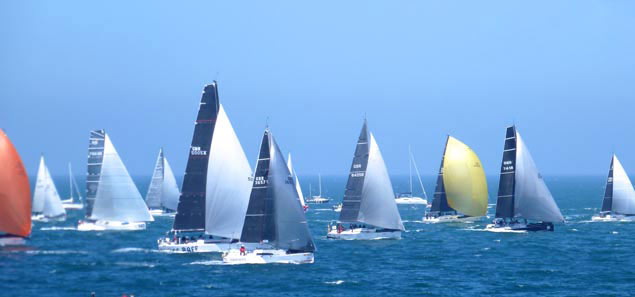 The Round Ireland fleet started their 704 mile race in the peak of summer weather
The Round Ireland fleet started their 704 mile race in the peak of summer weather
 The combined tracker charts reveal that some boats took real flyers to try to deal with the strong headwind conditions off the West Coast
The combined tracker charts reveal that some boats took real flyers to try to deal with the strong headwind conditions off the West Coast
Initially, this favoured the smaller boats which were making better time in the shelter of the south and southwest coasts, so much so that Niall Dowling (RIYC) with the much-fancied Ker 43 Baraka GP was lying in 24th overall as they battled against the Class 40 Corum for line honours along the north coast of Mayo. But as the rest of the fleet of 54 boats got into the full adversity of the Western Ocean, Baraka - with ace navigator Ian Moore on the strength - never put a foot wrong, and steadily worked her way up until she was out of sight ahead, taking line honours and the overall win.
Meanwhile, the coast of Donegal once again played havoc with hard-earned placings through flukey winds and localised calms, and those who did well, such as Chris Power Smith’s Aurelia and the J/109 Joker 2 (John Maybury, RIYC, skippered by Barry Byrne), did very well indeed, while others – it wouldn’t even be fair to mention them – found Donegal to be a complete gluepot, they were well stuck for hours.
In the end, it became a battle for the coveted Corinthian Trophy between Aurelia and Joker 2, and although at the finish Aurelia was briefly reckoned the winner, a re-appraisal of ratings gave it to Barry Byrne and his crew, a remarkable performance. Equally remarkable perhaps, but in a very different way, was the completion of the race by the classic 43ft 1937 Tyrrell-built gaff ketch Maybird (Darryl Hughes) the first time the race was ever sailed by a gaff rigged boat, and she was also the oldest ever to complete the course.
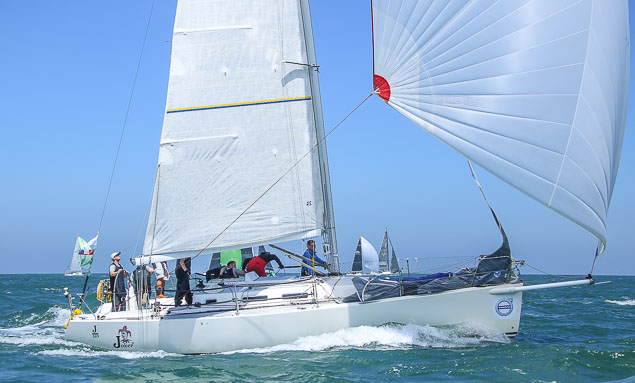 The J/109 Joker 2 (John Maybury) won the Corinthian Division in the Volvo Round Ireland Race, and successfully defended the Beaufort Cup in Volvo Cork Week, with a Defence Forces crew skippered by Commandant Barry Byrne. Photo: Afloat.ie/David O’Brien
The J/109 Joker 2 (John Maybury) won the Corinthian Division in the Volvo Round Ireland Race, and successfully defended the Beaufort Cup in Volvo Cork Week, with a Defence Forces crew skippered by Commandant Barry Byrne. Photo: Afloat.ie/David O’Brien
As the Round Ireland drew to its close, the four day Bangor Town Regatta on Belfast Lough – a joint venture between Royal Ulster YC, Ballyholme YC, and the local council - was getting into its stride in mostly superb sailing conditions. It was the successful modern revival of an ancient event, and attracted a fleet pushing towards a hundred, with the RC 35s over in strength from Scotland to promote their cause, so naturally, Pat Kelly and his team with Storm were there to take them on.
Storm missed the win by just one point, coming in a very close second to Kevin and Debbie Aitken’s First 36.7 Animal, which by season’s end was the 2018 RC 35 Champion. Storm meanwhile was saving her energies through the rest of July for a vigorous campaign at the Welsh IRC Nationals at Pwllheli and Abersoch in August, from which she emerged as overall winner, and also the winner of the RC 35s’ Celtic Championship for the combination of her results in the Scottish Series, Bangor Town Regatta, and the Welsh Championship.
Volvo Cork Week then came up on the radar, and inevitably its highlight is the Beaufort Cup series for Services Crews which is a very all-encompassing category, as it included, for instance, the formidable talents of Youen Jacob with the Baltimore Lifeboat crew racing a J/109. Defending champion, in a large and varied fleet in which J/109s were the boat of choice, was Commandant Barry Byrne and a Defence Forces crew with Joker 2 once more. At the series end, he was winner again after a mixture of inshore and offshore racing in which his results reminded some observers of a certain noted skipper who cheerfully admitted that he’d rather be lucky than thought of as good. Commandant Byrne is good as a helmsman too, but his ability to take wins when other boats seemed to be nearer the finish line was demonstrated in the 2018 Beaufort Cup series to a magical level.
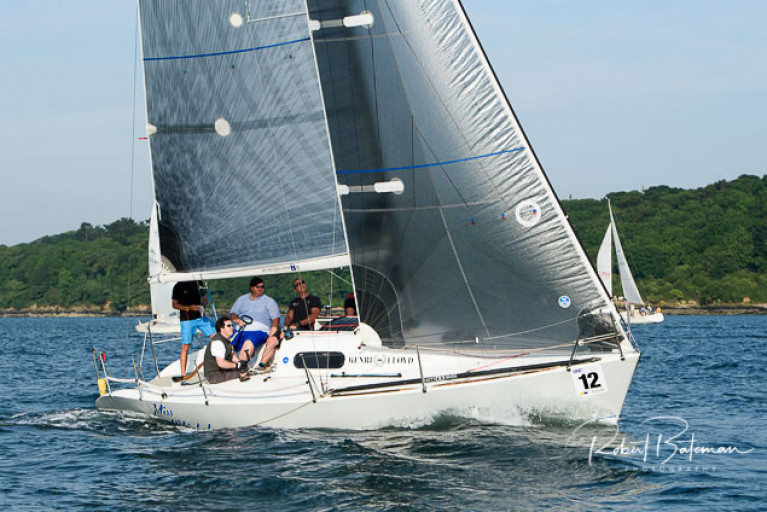 John & Ronan Dowling’s Half Tonner Miss Whiplash had a flawless final day at Volvo Cork Week to take the class victory. Photo: Robert Bateman
John & Ronan Dowling’s Half Tonner Miss Whiplash had a flawless final day at Volvo Cork Week to take the class victory. Photo: Robert Bateman
One of the best features of Volvo Cork Week generally was the way in which many classes went to the final day before results were decided, with John and Ronan Downing’s Half Tonner Miss Whiplash (RCYC) taking the overall win in style after overnight leader Harmony (Johnny Swann, HYC) got herself in a bit of a knot, despite having been the overall winner of the 92-strong Harbour Race on the Wednesday.
On up the size scale, and Frank Whelan’s Grand Soleil 44 Eleuthera from Greystones likewise put in a barn-storming final day’s performance with two wins, providing a well-deserved overall win for a recently-assembled yet rapidly-bonding crew who are prepared to put in the elbow grease on getting their boat in prime racing condition.
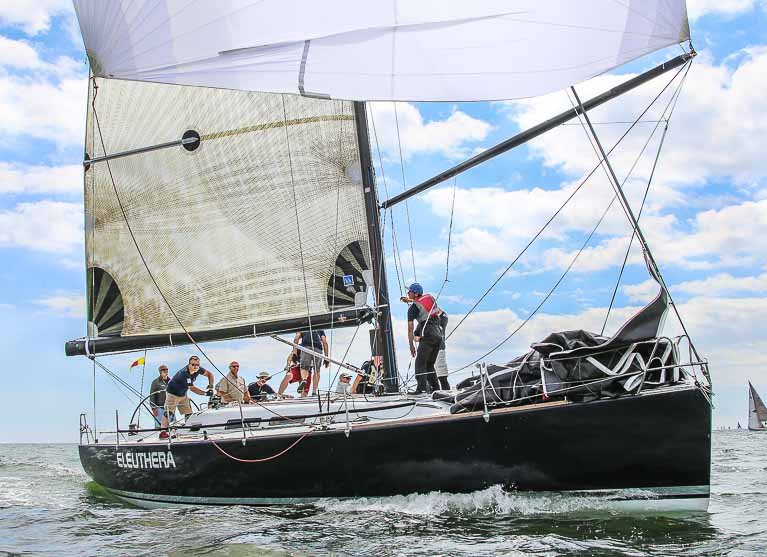 Frank Whelan’s Grand Soleil 44 Eleuthera from Greystones was one of 2018’s star performers on both the east and south coasts. Hoto; Afloat.ie/David O’Brien
Frank Whelan’s Grand Soleil 44 Eleuthera from Greystones was one of 2018’s star performers on both the east and south coasts. Hoto; Afloat.ie/David O’Brien
Eleuthera was featuring strongly as the popular four day Calves Week got under way in Schull as August took hold. But as August took hold, for Ireland at least the total summer weather seemed to have come to an end except along the south coast, where at places like Schull and Kinsale in August they’ll tell you that the very occasional drop of rain is no more than liquid sunshine anyway…..
As it happens, while the underlying weather pattern may have been deteriorating, Schull was largely blessed by its own micro-climate, the coast of that most purely West Cork part of West Cork was looking its loveliest, and they’d some splendid sailing, with Eleuthera the Boat of the Show in an event which perfectly captures the holiday mood of the moment.
However, as the prizes were being liberally distributed at Schull, another event came centre stage down at Cowes with the four-yearly 1800 miles RORC Sevenstar Round Britain and Ireland Race getting underway, with Conor Fogerty and Simon Knowles pitching for Ireland in the two-handed division in Fogerty’s Sunfast 3600 Bam.
At first, they were doing mighty well, but as the race progressed it became clear that all the two-handers were totally out-classed by two Volvo Ocean Race veterans from the successful Dongfeng. These super-tough guys were racing a Figaro 2 which just went faster and faster.
By the time they got to the west coast of Ireland where a westerly gale made in upon the fleet, the two Volvo tough men were in a race of their own, and it stayed that way to the end, so much so that it was almost irrelevant that Fogerty and Knowles had to retire after their last spinnaker halyard broke somewhere between Donegal and St Kilda.
Their frustration was not the only Irish disappointment caused by that very prolonged westerly gale. At the same time, it had been hoped to stage the Irish Cruiser Racer Association Nationals from Galway Harbour for the first time, but the fleet were stuck in port behind the harbour lock-gate as wind and waves came howling up Galway Bay, and the ICRA Nats 2018 became a non-event.
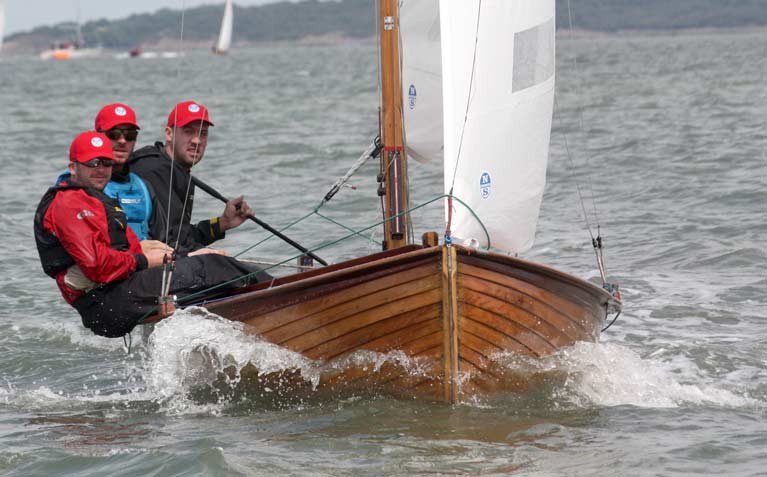 A popular success – Darragh McCormick won the mermaid nationals in his own-built Innocence at his home port of Foynes.
A popular success – Darragh McCormick won the mermaid nationals in his own-built Innocence at his home port of Foynes.
It was frustration in spades, but as ever, Irish sailing had an alternative story or three to cheer everyone up. Already in August we’d had the marvellous tale of how Darragh McCormick of Foynes had finally succeeded in winning the Mermaid National Championship in his beautiful own-built boat Innocence, and at his home port too, in a great week of racing. Darragh has shown he can race it with the best of them in J/24s and other newer boat types, but for him the Mermaid is everything, and this win was beyond everything.
Then even as things were being sadly packed up at Galway Harbour, the veteran GP 14s arrived in strength at Rosses Point in Sligo for their Irish Nationals. The weather relented at last, they got in a full programme, and ex-Pat Geep sailor Ross Kearney (RNIYC), having taken second overall at the Worlds in Cornwall a fortnight earlier, took the win though at times seriously veteran oldies like Curly Morris were giving him a hard time.
And then there’s the story of how the two little Half Tonners Checkmate XV (Dave Cullen) and Harmony (Johnny Swann) road-trailed their way from Howth to Belgium for the Half Ton Classics at Nieuwpoort, and how they came home a week later with the big cup and the second prize too, despite having very different management styles. Dave is a management perfectionist, with everything planned weeks and months and even years in advance, whereas Johnny tends to wing it – he’s not called Swann for nothing. Either way, it worked, and gave observers much enjoyment.
As for Olympic sailing, while the Hempel Sailing World Championship in August at Aarhus in Denmark (a fleet of 1,100 boats – can you even begin to imagine it?) was disappointing for the Irish contingent, with no place as yet secured for Tokyo, 2018 ended on something of a high, as the big-fleet Laser Nationals on Lough Derg in August showed rising talents, none more so than Aisling Keller of the host club, who won the 48-strong radial fleet in very convincing style.
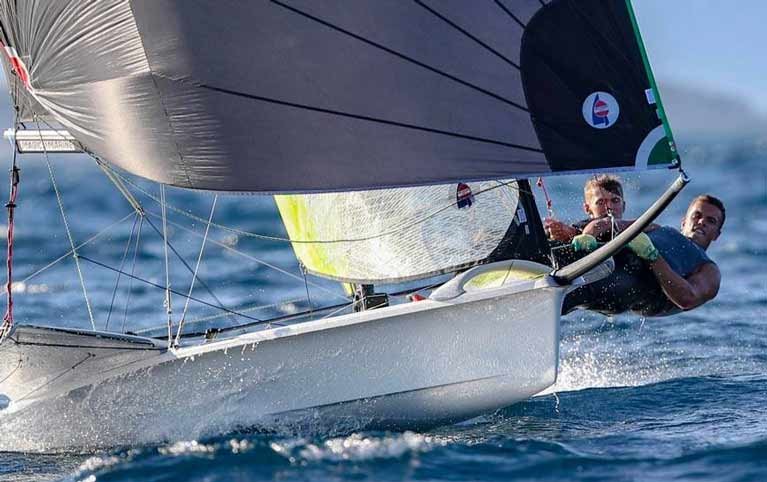 Gold Medallists! Robert Dickson and Sean Waddilove in the 49er
Gold Medallists! Robert Dickson and Sean Waddilove in the 49er
And then in September out of the blue, there came a Gold Medal from Marseille in the 49er Under 23 Worlds for Robert Dickson of Howth and Sean Waddilove of Skerries. This determined duo have been quietly building their campaign and racing skills for some years. But now, suddenly and in sometimes very breezy conditions in the south of France, it all clicked - they put together a text-book performance, and the Gold was well won.
September saw a rush of events, particularly in its first fortnight. Abroad, La Solitaire URGO Le Figaro in France, still known to every as the Figaro Solo, had added Irish interest with Tom Dolan of Meath in Smurfit Kappa and Joan Mulloy of Mayo in Taste the Atlantic taking part. It was first time for both in the 49th staging of a classic which next year, for its Golden Jubilee, will go foiling with the new Figaro 3 (Conor Fogerty has already ordered one), but for 2018 the versatile Figaro 2 continued to give great service.
In two weeks with four stages on the coasts of France and Spain, with the conclusion at St Croix on France’s Biscay coast, both Irish rookies had their moments, but although Joan Mulloy’s gallant challenge attracted much goodwill at home and abroad, despite times when she was in the frame, her overall placing showed what she was up against, and a month after the event was over, she announced that it as no longer possible in the time available to muster the resources for her Vendee Globe aspirations.
For Tom Dolan, a rigging failure which fortunately was saved from being a broken mast in the first leg put paid to his overall chances, and it wasn’t until the third stage, from Portosin in Spain across Biscay to St Croix, that he found form to be figuring among the top twelve, and finishing the leg as first rookie was good going by Figaro standards – the eventual overall winner, Sebastien Simon who already has a Vendee Globe 2020 campaign in place, was finally taking the Figaro’s top prize at his fifth attempt.
Back home, that first half of September saw Dublin Bay come centre stage on the international scene with the International SB20 Europeans staged by the Royal Irish YC, followed almost immediately by the daddy of them all, the World Laser Masters hosted in a remarkable exercise of logistics by the Royal St George with the support of the National YC and Dun Laoghaire Rathdown Council.
In the SB 20s, the competition was both truly international and very demanding, but three Irish boats managed to get into the top ten at the finish. And though the Russian Vis Sailing crew led by Artem Basalkin set the pace to take the Gold, that meticulous preparer of campaigns, Michael O’Connor of Royal St George crewed by Davy Taylor and Edward Cook put in a solid performance to take the bronze.
With more than 300 boats taking part with helms including many of world sailing’s legends of dinghy racing past and present, the utterly international Laser Masters World Championships 2018 was one of 2018’s megafests of global sailing, and Dublin Bay served up mostly quite brisk mainly westerly breezes to keep these seniors on their toes for a week of sailing.
For outsiders, there seemed an almost bewildering range of categories, but a day’s familiarity was all that was required to appreciate the difference between the Apprentice Masters and the Legends, with the many gradations between. Irish attention soon focused on the Grand Masters – sailors between 55 and 65 – and our 1996 Olympic Laser Representative Mark Lyttle of the National Yacht Club, who soon showed himself among the front runners in this category, but saved it until the last race to finally clinch the title, a very popular win.
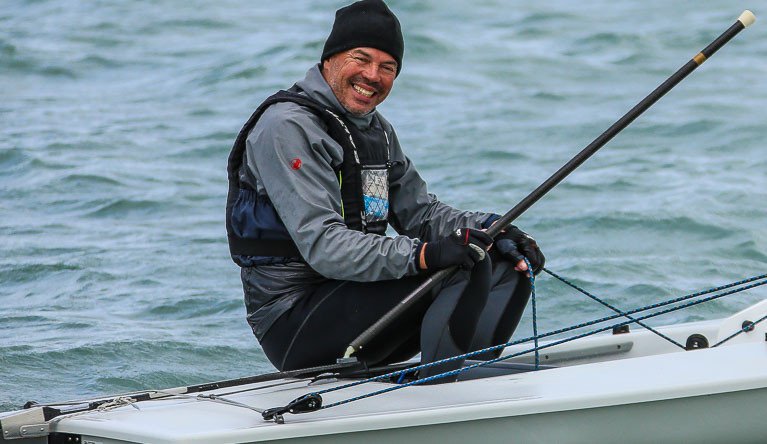 The ultimate winning feeling – Mark Lyttle after taking the title in the Laser Grand Masters Worlds on the final day. Photo: Afloat.ie/David O’Brien
The ultimate winning feeling – Mark Lyttle after taking the title in the Laser Grand Masters Worlds on the final day. Photo: Afloat.ie/David O’Brien
The scale of the event, and the extraordinary variety and multi-faceted sailing stories of those taking part, would comfortably fill several books. But as ever, Dun Laoghaire’s historic harbour and waterfront stylishly welcomed the enormous fleet back to shore after each day’s racing, and many friendships were renewed or established among an exceptional group of people.
Yet even as these notable international championships dominated the headlines, more local series were drawing to a close, with the 2018 ISORA Championship going right to the wire in the last race in September with the James Eadie Cup, and once again Pwllheli’s J/109 Mojito (Vicky Cox and Peter Dunlop) pulled off the Wolf’s Head Trophy for overall winner by the smallest of margins.
On the inshore racing front, the elegant International Dragons took themselves to beautiful Glandore in considerable numbers for their four day Irish National Championships, and the winner in brisk conditions was Phantom (Neil Hegarty RStGYC, crewed by David Williams and Peter Bowring), but they’d to fight right to the end of the last race to snatch the title from Martin Byrne’s Jaguar (RStGYC) and Cameron Good of Kinsale’s Little Fella.
 Neil Hegarty’s Phantom became the 2018 Irish Dragon Champion at Glandore in September.
Neil Hegarty’s Phantom became the 2018 Irish Dragon Champion at Glandore in September.
While the Dragon racing was at times rough going off Kinsale, it was beyond the bounds of comparison to draw any analogy with the wild wastes of the Southern Indian ocean, where the leaders in the Golden Jubilee Golden Globe Solo Round the World Race were at times battling survival conditions. Ireland’s Gregor McGuckin had been showing well overall with his veteran Biscay 36 Hanley Energy Endurance, sailing along in third or fourth place, when on Friday September 21st he and his nearest competitor, Abilash Tomy of India who was 90 miles distant, were struck by the perfect storm. Both were rolled and lost their rigs, but while Tomy’s single roll was enough to leave him mastless and personally disabled with a fractured spine, it took two 360 degree rolls to complete the dismasting of McGregor’s boat.
Both boats were as far as possible from any significant land-based rescue and Tomy’s condition was potentially fatal, so despite the appallingly rapid rolling motion of a mastless boat in a chaotic sea, McGregor erected his jury rig with dogged persistence, and set off under sail and power to get to Tomy. He’d to hand steer all the way as nearly all systems on the boat were down, and had got to within 30 miles of the casualty when – unexpectedly early – help arrived in the form of the French Fisheries Patrol vessel Osiris, whose crew successfully rescued Abilash Tomy and then went to the Irish skipper, as it had been agreed that his total remoteness and limited resources pointed to a controlled evacuation of the Irish boat as the most seamanlike decision.
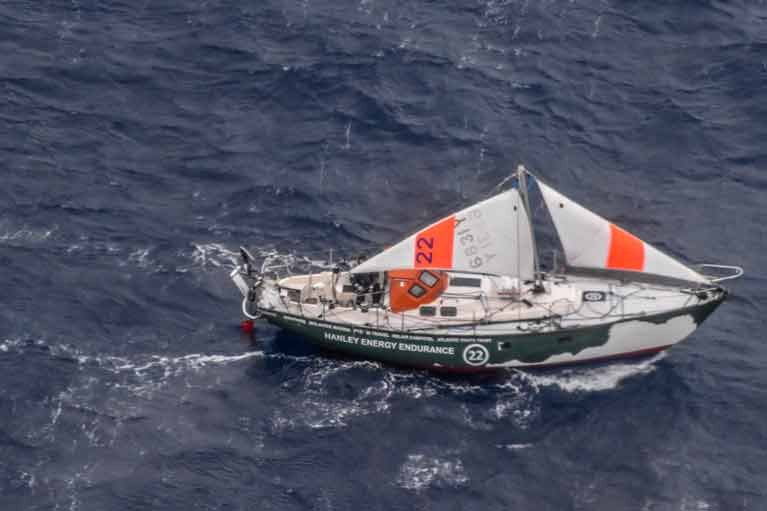 Gregor McGuckin's Hanley Energy Endurance under jury rig in his gallant attempt to help Abilash Tomy
Gregor McGuckin's Hanley Energy Endurance under jury rig in his gallant attempt to help Abilash Tomy
The two solo sailors were taken to Amsterdam Island where Tomy – a serving naval officer – was retrieved by the Indian Navy and was soon undergoing spinal surgery, while McGuckin was collected by the Royal Australian Navy with HMAS Ballarat and taken to Perth to discover that his selfless act in performing superhuman feats of ingenuity in providing his crippled boat with the means to head towards Tomy had made him into a hero, and rightly so.
After this epic incident, it was a relief to return to the steadily unfolding pattern of the established Irish sailing season, and the final weekend of September saw the Flying Fifteen National Championship hosted in Dublin Bay by the National YC, an event of added significance as the same setup will be staging the 2019 Flying Fifteen Worlds. But that added importance didn’t upset the convincing style of Dave Gorman and Chris Doorly, who went into the final breezy day with such a good lead that they need only one more top six result to give them the title, and they duly delivered.
That same weekend, the All-Ireland Junior Championship in Dun Laoghaire was hosted by Royal St George and raced in classic style in Firefly dinghies. There was enough westerly wind around on the second day – as the Flying Fifteens were discovering out in the bay - for Race Officer David Lovegrove to move the racing into Dun Laoghaire’s capacious harbour, and if anything the competition heated up. But regular Dun Laoghaire sailing experience didn’t prove to be any advantage, as the Cork juniors were making hay, the overall win being taken by 16-yeat-old Atlee Kohl of Royal Cork YC, a top 29er and Laser 4.7 sailor, crewed by 14-year-old Jonathan O’Shaughnessy.
 Cut and thrust…..racing for the All Ireland Junior Title, which was won by Atlee Kohl of Royal Cork. Photo Afloat.ie/David O’Brien
Cut and thrust…..racing for the All Ireland Junior Title, which was won by Atlee Kohl of Royal Cork. Photo Afloat.ie/David O’Brien
Thus the junior title was won by a crew from the world’s oldest yacht club, so there was a certain symmetry when, a week later in the first weekend of October, the senior title, the time-honoured All-Ireland Helmsman’s Championship, was staged for its 71st occasion by Ireland and the world’s second-oldest yacht club, the 1770-founded Lough Ree YC near Athlone.
Last year, it was raced in GP 14s on Lough Owel near Mullingar, and again in 2018 it was a strong class association - in this case the SB 20s - which stepped up to the plate to provide the boats for an intensive weekend of competition in sometimes hectic sailing.
Theoretically, the SB 20s are a compromise boat which can suit dinghy or keelboat helms. But experience with the class was no drawback for former Olympian Peter Kennedy of Strangford Lough, who had won the SB 20 Nationals at the NYC in June crewed by Stephen Kane and Hammy Baker, and Kane was aboard with him at Lough Ree to ensure that his skipper added the historic silver salver to his trophy collection for 2018.
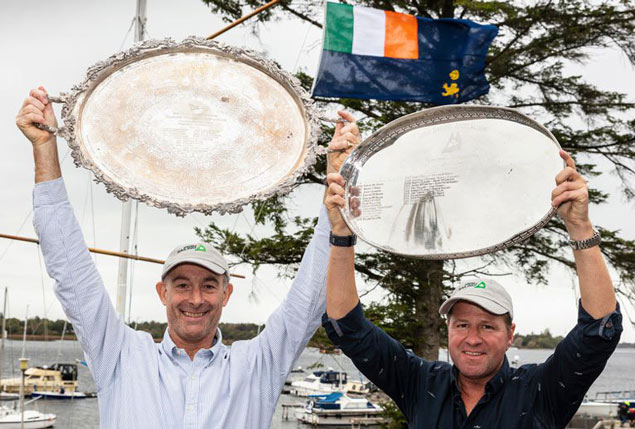 Peter Kennedy and Stephen Kane with their prizes at the All Ireland Championship at Lough Ree. Photo: Irish Sailing/David Branigan
Peter Kennedy and Stephen Kane with their prizes at the All Ireland Championship at Lough Ree. Photo: Irish Sailing/David Branigan
On the same weekend, the Dublin Bay J/109s sent their finest to Howth for the Irish Nationals, and though after early racing in strong breezes Tim Goodbody (RIYC) in White Mischief was narrowly the overnight leader, the final day’s racing saw Juggerknot (Andrew Algeo & partners, RIYC) showing the excellent form she’d demonstrated all season to win overall with White Mischief second and Pat Kelly with Storm from the host club third.
 Irish J/109 National Champions 2018 – Juggerknot (Andrew Algeo & partners, RIYC) Photo: Afloat.ie/David O’Brien
Irish J/109 National Champions 2018 – Juggerknot (Andrew Algeo & partners, RIYC) Photo: Afloat.ie/David O’Brien
October can be the sweetest sailing month if a gentle Autumn settles in, and there was a special spirit to the KBC Autumn League at Howth, where the vintage Howth 17s showed they’d almost completely recovered from their setback in Storm Emma at the beginning of March, and were out racing in strength throughout the season and especially in September, with fourteen boats – including four of the original five 1898-built ones - coming to the line every Saturday.
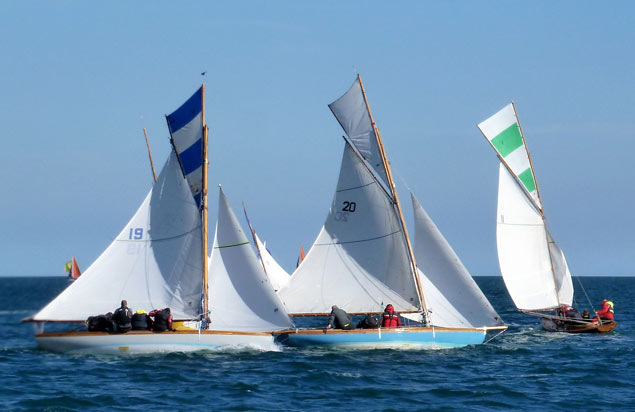 The indestructible Howth Seventeens are well advanced in their recovery from the damage of Storm Emma, and fourteen have been regularly racing in the KBC Autumn League at Howth, with Isobel, Sheila and Deilginis seen here at the weather mark on a perfect September day. Photo: W M Nixon
The indestructible Howth Seventeens are well advanced in their recovery from the damage of Storm Emma, and fourteen have been regularly racing in the KBC Autumn League at Howth, with Isobel, Sheila and Deilginis seen here at the weather mark on a perfect September day. Photo: W M Nixon
Conditions have been more varied on the south coast where the Royal Cork has been mustering a godly turnout for its Autumn League with a notably modern-looking fleet, but far to the west on the Shannon Estuary, classic gaff rig resumed a certain prominence, with the fully-restored and sea-certified Ilen returning at last to her home port of Limerick after 92 years away, her rapturous welcome including a charming visit to the ship and a meeting with her crew and restorers by President Michael D Higgins and his wife Sabina.
On down the Shannon Estuary at Kilrush, which is where our narrative of Ireland’s 2018 sailing seems to have begun, they had some of the best late season weather of all for their Autumn League. And there was a very special success when the community-built Shannon cutter replica Sally O’Keeffe, built by a group in Querrin out towards Loop Head under the direction of Steve Morris to a design by Myles Stapleton, was the winner of the non-spinnaker class in the opening race.
So having begun in Kilrush with 194 sailing students descending on the place for their annual Irish Universities Team Racing Championship in early March, we end our story back in Kilrush in October with a significant race win by a locally-built gaff cutter of a type nearly two hundred years old. In between these two place-related occurrences, it seems that quite a lot of things have happened. But that’s how it is in Irish sailing, and especially in 2018.
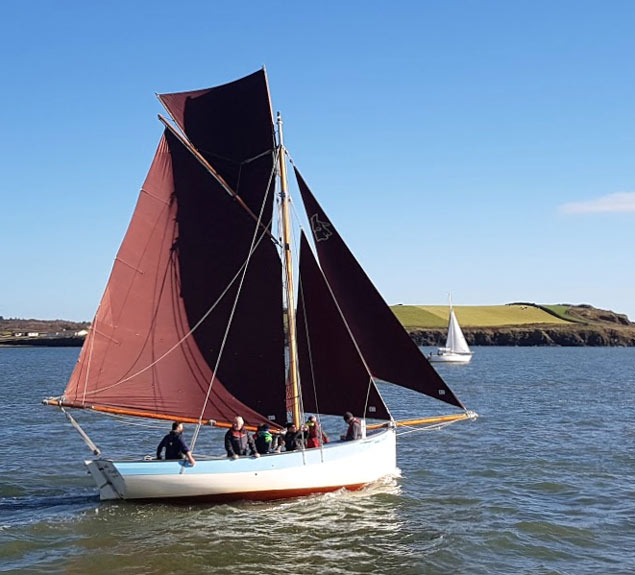 Local talent. The traditional cutter Sally O’Keeffe won the first race of the Autumn League at Kilrush
Local talent. The traditional cutter Sally O’Keeffe won the first race of the Autumn League at Kilrush
































































